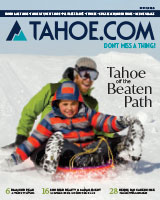
It's time once again to get ready for a cold and blustery winter wonderland here in Lake Tahoe.
The weather forecast predicts a gigantic 5 feet of new snow heading our way, making it the perfect time for a reminder on what we need to do to keep ourselves, our loved ones and others safe this winter season.
To help make sure we are all on the same program, this blog is dedicated to seven ways we can personally participate in staying safe as Jack Frost comes nipping at our noses. Please feel free to add any other points that you think are important in the comments below. Happy snowy wonder world everyone!
Winterize your car
One mandatory aspect of winter driving in Lake Tahoe is to make sure that your automobile is winterized. What does winterizing your car mean? There are various factors that contribute to a car or truck being ready for winter. Be sure that you have snow tires or studs. Have your car tuned and its appropriate fluids checked, replaced or topped off as needed. Replace windshield wipers with new, snow-friendly blades. Check your brakes. Replace your windshield-wiper fluid with a solution that is appropriate for freezing temperatures. Most importantly, be sure to have the extra items needed in case of road closures or getting stuck, like an extra blanket, water, shovel, chains, small bit of food and flashlight.
Take it slow
There is a new campaign in Lake Tahoe reminding locals and visitors to drive safely while in this beautiful region of the world. In collaboration with Take Care Tahoe, the Take it Slow, Tahoe campaign reaches out to drivers, imploring them to protect pedestrians, cyclists and animals through slow driving. An ever-increasing problem in the basin is the frequency of people driving at high speeds in slow zones. This disregard for driving within the speed limit met a tragic end this summer for a CalTrans worker who was hit and killed by a speeding driver. Driving slowly and staying aware is even more important with the coming of winter's weather, colder temperatures and slick roads. Victoria Ortiz, community engagement manager for the Tahoe Regional Planning Agency, would like to remind drivers, “By driving slower, you have more time to react if a pedestrian steps off a curb, a biker swerves to avoid a pothole or a bear crosses the highway. Plus, it gives you more time to soak in all that Tahoe has to offer.”

Keep yourself layered
One aspect to living in a cold environment is that layering your clothes is a part of the game. As the saying goes: You can always take off a layer. Why is layering so important? Dressing in layers helps create extra insulation for the body. The clothing that is closest to your skin should be made of fabric that has moisture-wicking capabilities. Be certain to never wear cotton as your base layer as cotton has a hard time drying once moistened by perspiration. There is another saying in the mountain world: Cotton kills. This is true and is a rule to be taken seriously. After the base layer, make sure your subsequent layers are easy to take on and off as the temperatures in Tahoe are ever-changing.
Stay mindful of your body temperature
An important part of staying safe in our snowy winter wonderland is to be mindful about not letting the body get too cold. Wet clothing and cold temperatures can make for a serious situation. These two components can quickly lead to hypothermia, which can arrive without warning in harsh circumstances, like being stuck on a road in a snowstorm after trying to dig yourself out. Other than keeping your layers dry, other ways to help with maintaining a healthy body temperature in cold climates include wearing a warm hat, covering the wrists, toes and ankles to help trap body heat, keeping an extra set of dry clothes on hand at all times and not missing that cup of hot chocolate when the opportunity arises.

When you arrive to your house and find the entrance snowed in, proper, layered clothing could be a lifesaver. Photo by Shanie Matthews
Be brain smart
This might not be exactly the subject that is thought of when the conversation turns to winter safety, but one point that is all too important here in Lake Tahoe is the use of helmets. In an area that has 13 different ski resorts, all with their own version of terrain, wearing a helmet whether skiing, snowboarding or sledding is a smart move. Many of the ski resorts around the area make it mandatory for children involved in ski programs to wear a helmet. This is because, according to the American Academy of Pediatrics, for the age range of 7 to 17 the use of helmets is vital to ensuring healthy brains. When shopping for a helmet, be sure that the helmet meets required safety recommendations for the sport that you are wearing it for. For example, a bike helmet does not work for skiing. Also be sure that the helmet is snug but at the same time comfortable and stays centered without excessive movement forward or backward.
Take breaks
One of the most important aspects to having fun in the great outdoors when it is cold out is to make sure you include frequent breaks into your day. Try to take a break every half-hour to hour to take inventory of yourself and those with you. This helps to keep everyone properly fueled, hydrated and protected from the cold and sun. This is also a great time to ask how everyone is feeling and take the necessary actions to make sure everyone in your group stays warm.
Be aware of tell-tales
When enjoying the bliss that comes with a snowy playground, it's easy to miss the cues that danger is lurking. Start to become a reader of the signs and symptoms of problems, catching them before they occur. Take, for example, skin color. Be mindful of how red skin is getting or if the skin is turning pale, grey or is blistering, especially on fingers, ears, nose or toes. Once the skin begins to turn grey, this is a sign that frost nip or potential frost bite is near, which if left unhindered can result in the loss of life or limb. Hypothermia signs to be aware of include excessive shivering, slurred speech, clumsiness, exhaustion, fumbling feet or hands and memory loss.
While staying safe in Lake Tahoe, be sure to enjoy one of the impressive events happening. Find out more at our Daytime or Nightlife sections.
Photo at top: The author, Shanie Matthews, playing safely in the Tahoe snow.


 A longtime Lake Tahoe local, Shanie is a freelance writer, Vinyasa Flow yoga teacher and positivity warrior. A true lover of the the gorgeous Tahoe region, she connects with the serenity of the mountains via skiing, biking and backpacking. She also believes in the gift of yoga and its way of allowing one to become his or her true best self, a passion she shares with the world with her online yoga studio.
A longtime Lake Tahoe local, Shanie is a freelance writer, Vinyasa Flow yoga teacher and positivity warrior. A true lover of the the gorgeous Tahoe region, she connects with the serenity of the mountains via skiing, biking and backpacking. She also believes in the gift of yoga and its way of allowing one to become his or her true best self, a passion she shares with the world with her online yoga studio.






